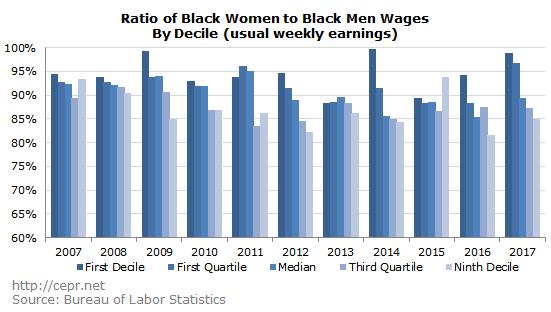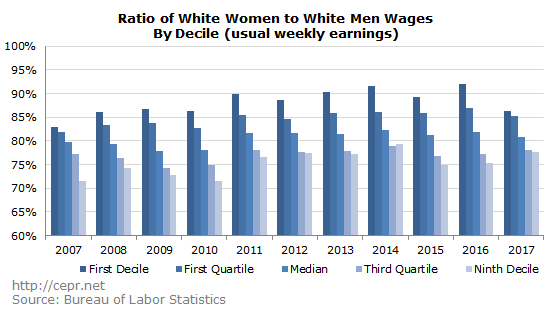October 31, 2017
Women in the United States across races and ethnicities make approximately 80 cents to a man’s dollar. However, some groups of women make disproportionately less than that; namely blacks and Hispanic/Latina women, making the wage gap an issue that strongly depends on gender, race, and ethnicity.
A closer look at Bureau of Labor Statistics data on usual weekly earnings by race, ethnicity and gender shows that the gender wage gap increases as earnings increase across all races and ethnicities. In addition, the divide between men and women’s earnings widens at a steeper rate among whites and Asians than with blacks and Hispanics/Latinos. At the first decile, black women and Hispanic/Latina women make earnings far closer to that of their black and Hispanic/Latina male counterparts than white and Asian women do to their respective male counterparts.
Though the gender wage gap widens as people get richer, this occurs differently across races and ethnicities. For instance, as black women get richer, they earn less relative to their black male counterparts within the same decile or quartile. Black women in the first decile are proportionately much closer to making the equivalent of black male earnings than they are in the third quartile.

In 2007, black women in the first decile made 94.5% of their black male counterparts. Black women in the third quartile in 2007 made 89.5% of their black male counterpart’s earnings in the third quartile. The trend from 2007-2017 shows a general increase in the gender wage gap for black women as they increase their income, meaning that black women become more unequal in comparison to black men as they get richer. The gender wage ratio for Hispanic/Latinas follows a similar trend to this.

However, as shown above, as white women climb the economic ladder and become richer, their earnings fall off more relative to their white male counterparts than is the case with black women. In 2007, white women in the first decile made 83% of their white male counterparts. In the third quartile this drops down to 77% and in the ninth decile to just 72%. White women in the third quartile make much less relative to white males at the same point in the wage distribution than is the case with black women. The situation is very similar with Asians as it is with whites, maintaining a disproportionately larger gender wage gap. In other words, the Hispanic/Latino and black gender wage gap is smaller across every decile than it is for whites and Asians, although it is important to note that black and Latina women earn less than their white counterparts at the same point in the wage distribution.
By examining the gender wage gap by race/ethnicity and usual weekly earnings quartiles and deciles, it is clear that increases in earnings correlate to a widening of the gender wage gap within race/ethnicity despite racial or ethnic group. Additionally, the gap widens at different rates for each racial/ethnic group as their earnings increase.
Although the gap between men and women’s earnings for each racial/ethnic category increases as earnings increase, the gap within each racial/ethnic category increases at a different rate. Notably, white women and Asian women in the first decile make much less proportionately than their male counterparts, while black and Hispanic/Latina women’s usual weekly earnings are proportionately much closer to their respective male counterparts.
The earnings ratio for blacks and Hispanic/Latinos never averages below 85% of their male counterparts wages, whereas white and Asian women’s earnings sometimes average below 75%. When comparing rates of relative earnings loss as women get richer, Hispanic/Latina and black women consistently show lower rates than white and Asian women do compared to their male counterparts.
Though the data shows an increase in the gender wage gap as earnings increase, it is important to note the limitations of usual weekly earnings summary data as a measure of the gender wage gap. A considerably smaller share of women workers are full-time workers, so the subset in this comparison is less representative of women in the labor force than men. Also, even for full-time workers there are differences in average hours worked. The reported average workday of full-time working women is 0.7 hours (42 minutes) less than that of men. As a result of these and other issues, this is a very limited measure of earnings gaps. Nonetheless there is an interesting pattern showing that white and Asian women have been catching up to the earning levels of white men, therefore narrowing the overall gender wage gap. However, within their own race, both white and Asian women make far less proportionately to their male counterparts as they get richer.






